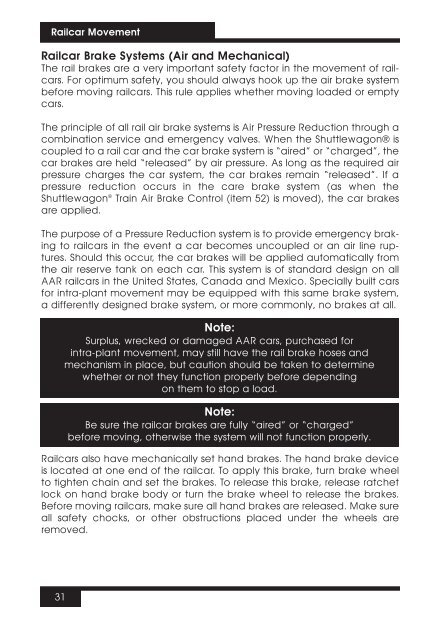SWX â€B†Series Operator's Manual - Shuttlewagon mobile railcar ...
SWX â€B†Series Operator's Manual - Shuttlewagon mobile railcar ...
SWX â€B†Series Operator's Manual - Shuttlewagon mobile railcar ...
Create successful ePaper yourself
Turn your PDF publications into a flip-book with our unique Google optimized e-Paper software.
Railcar Movement<br />
Railcar Brake Systems (Air and Mechanical)<br />
The rail brakes are a very important safety factor in the movement of <strong>railcar</strong>s.<br />
For optimum safety, you should always hook up the air brake system<br />
before moving <strong>railcar</strong>s. This rule applies whether moving loaded or empty<br />
cars.<br />
The principle of all rail air brake systems is Air Pressure Reduction through a<br />
combination service and emergency valves. When the <strong>Shuttlewagon</strong>® is<br />
coupled to a rail car and the car brake system is “aired” or “charged”, the<br />
car brakes are held “released” by air pressure. As long as the required air<br />
pressure charges the car system, the car brakes remain “released”. If a<br />
pressure reduction occurs in the care brake system (as when the<br />
<strong>Shuttlewagon</strong> ® Train Air Brake Control (item 52) is moved), the car brakes<br />
are applied.<br />
The purpose of a Pressure Reduction system is to provide emergency braking<br />
to <strong>railcar</strong>s in the event a car becomes uncoupled or an air line ruptures.<br />
Should this occur, the car brakes will be applied automatically from<br />
the air reserve tank on each car. This system is of standard design on all<br />
AAR <strong>railcar</strong>s in the United States, Canada and Mexico. Specially built cars<br />
for intra-plant movement may be equipped with this same brake system,<br />
a differently designed brake system, or more commonly, no brakes at all.<br />
Railcars also have mechanically set hand brakes. The hand brake device<br />
is located at one end of the <strong>railcar</strong>. To apply this brake, turn brake wheel<br />
to tighten chain and set the brakes. To release this brake, release ratchet<br />
lock on hand brake body or turn the brake wheel to release the brakes.<br />
Before moving <strong>railcar</strong>s, make sure all hand brakes are released. Make sure<br />
all safety chocks, or other obstructions placed under the wheels are<br />
removed.<br />
31<br />
Note:<br />
Surplus, wrecked or damaged AAR cars, purchased for<br />
intra-plant movement, may still have the rail brake hoses and<br />
mechanism in place, but caution should be taken to determine<br />
whether or not they function properly before depending<br />
on them to stop a load.<br />
Note:<br />
Be sure the <strong>railcar</strong> brakes are fully “aired” or “charged”<br />
before moving, otherwise the system will not function properly.




